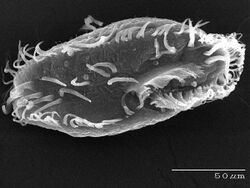Biology:Oxytricha trifallax
| Oxytricha trifallax | |
|---|---|

| |
| Scientific classification | |
| Domain: | Eukaryota |
| Clade: | Diaphoretickes |
| Clade: | SAR |
| Clade: | Alveolata |
| Phylum: | Ciliophora |
| Class: | Spirotrichea |
| Family: | Oxytrichidae |
| Genus: | Sterkiella |
| Species: | S. histriomuscorum
|
| Binomial name | |
| Sterkiella histriomuscorum | |
| Synonyms[1] | |
| |
Sterkiella histriomuscorum, formerly Oxytricha trifallax, is a ciliate species in the genus Sterkiella, known for its highly fragmented genomes which have been used as a model for ciliate genetics.
Genetics
Like all ciliates, O. trifallax has two different types of nuclei: macronuclei, which are the site of transcription and gene expression, and micronuclei, which are only active during sexual reproduction but are otherwise transcriptionally inactive. Macronuclei are formed by the differentiation of micronuclei, which usually involves some degree of RNA-mediated DNA editing. O. trifallax is the first species sequenced with an unusually high degree of fragmentation in its macronuclear genome. Up to 96% of the micronuclear genome is eliminated during the differentiation into a macronucleus; in comparison, in other ciliates like Paramecium only about 30% is eliminated. The macronuclear genome has a haploid size of about 50 Mbp.[2]
The chromosomes of the macronucleus are also unusually short. The macronuclear genome encodes about 18,500 genes, but these are distributed on 16,000 chromosomes, which are called nanochromosomes due to their length.[2][3] Because of their unusually short nanochromosomes, most of which contain only a single gene, they have been used as a model organism to study telomeres and to screen for non-coding RNA genes.[4]
The micronuclear genome has also been sequenced, and contains about 3,500 scrambled genes. Scrambled genes are genes whose individual segments are located in different parts of the micronuclear genome, and therefore have to be "unscrambled" during the DNA editing step into a conventional gene in the macronuclear genome. More than 225,000 individual DNA segments have to be unscrambled during the development of a macronuclear genome from its micronuclear precursor.[5]
The mitochondrial genome has also been sequenced, and is the largest known ciliate mitochondrial genome, with a length of about 70 kbp. Like other ciliate mitochondrial genomes, those of O. trifallax are linear molecules and contain a number of split genes. Their mitochondria also possess a separate plasmid, which may have been involved in horizontal gene transfer during the evolution of the mitochondrial genome.[6]
Taxonomy and systematics
The taxonomy of O. trifallax has been contested. It was reclassified as Sterkiella histriomuscorum on the basis of morphological characteristics, but a molecular phylogeny supports the original classification as a species of Oxytricha.[7]
References
- ↑ Warren, A. (2019). World Ciliophora Database. Sterkiella histriomuscorum (Foissner, Blatterer, Berger & Kohmann, 1991) Foissner, Blatterer, Berger & Kohmann, 1991. Accessed through: World Register of Marine Species at: http://www.marinespecies.org/aphia.php?p=taxdetails&id=427777 on 2019-01-07
- ↑ 2.0 2.1 Swart, Estienne C.; Bracht, John R.; Magrini, Vincent; Minx, Patrick; Chen, Xiao; Zhou, Yi; Khurana, Jaspreet S.; Goldman, Aaron D. et al. (2013-01-29). "The Oxytricha trifallax Macronuclear Genome: A Complex Eukaryotic Genome with 16,000 Tiny Chromosomes". PLOS Biology 11 (1): e1001473. doi:10.1371/journal.pbio.1001473. ISSN 1545-7885. PMID 23382650.
- ↑ "This Bizarre Organism Builds Itself a New Genome Every Time It Has Sex" (in en-US). WIRED. https://www.wired.com/2014/09/oxytricha-encrypted-genome/.
- ↑ Jung, S.; Swart, E. C.; Minx, P. J.; Magrini, V.; Mardis, E. R.; Landweber, L. F.; Eddy, S. R. (2011-09-01). "Exploiting Oxytricha trifallax nanochromosomes to screen for non-coding RNA genes" (in en). Nucleic Acids Research 39 (17): 7529–7547. doi:10.1093/nar/gkr501. ISSN 0305-1048. PMID 21715380.
- ↑ Chen, Xiao; Bracht, John R.; Goldman, Aaron David; Dolzhenko, Egor; Clay, Derek M.; Swart, Estienne C.; Perlman, David H.; Doak, Thomas G. et al. (2014). "The Architecture of a Scrambled Genome Reveals Massive Levels of Genomic Rearrangement during Development". Cell 158 (5): 1187–1198. doi:10.1016/j.cell.2014.07.034. PMID 25171416.
- ↑ Swart, Estienne C.; Nowacki, Mariusz; Shum, Justine; Stiles, Heather; Higgins, Brian P.; Doak, Thomas G.; Schotanus, Klaas; Magrini, Vincent J. et al. (2012-01-01). "The Oxytricha trifallax Mitochondrial Genome". Genome Biology and Evolution 4 (2): 136–154. doi:10.1093/gbe/evr136. PMID 22179582.
- ↑ Zoller, Stephen D.; Hammersmith, Robert L.; Swart, Estienne C.; Higgins, Brian P.; Doak, Thomas G.; Herrick, Glenn; Landweber, Laura F. (2012). "Characterization and Taxonomic Validity of the Ciliate Oxytricha trifallax (Class Spirotrichea) Based on Multiple Gene Sequences: Limitations in Identifying Genera Solely by Morphology". Protist 163 (4): 643–657. doi:10.1016/j.protis.2011.12.006. PMID 22325790.
Other resources
- "OxyDB | Oxytricha Genome Database Wiki". http://oxy.ciliate.org/index.php/home/welcome.
- "In one of nature's innovations, a single cell smashes and rebuilds its own genome". http://www.princeton.edu/main/news/archive/S41/01/85G88/index.xml?.
Wikidata ☰ Q15378940 entry

